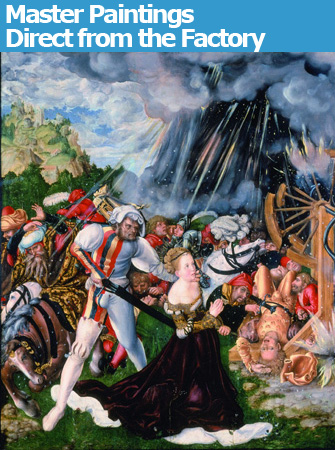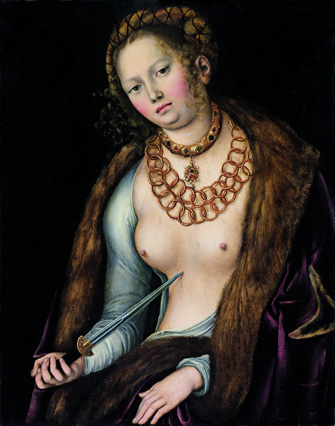 |
|
“The Martyrdom of Saint Catherine” (1508-09) by Lucas Cranach the Elder. © Ráday Library of the Hungarian Reformed Church, Budapest |
A mystery surrounds the authorship of the paintings of Lucas Cranach the Elder (1472-1553). Like today’s fashion and object designers (and …
 |
|
“The Martyrdom of Saint Catherine” (1508-09) by Lucas Cranach the Elder. © Ráday Library of the Hungarian Reformed Church, Budapest |
A mystery surrounds the authorship of the paintings of Lucas Cranach the Elder (1472-1553). Like today’s fashion and object designers (and some contemporary artists), Cranach was so successful that after a certain point he could afford to have others do the actual work while he supplied the “vision” and perhaps applied his skilled hand to certain important paintings. As was not unusual at the time, his workshop was a well-run factory, with pre-defined formats, color codes and visual elements (faces, clothing, animals, etc.) that could be combined in a variety of ways. After his death, the studio carried on in the same manner under the direction of his son, Lucas Cranach the Younger.
Born Lucas Maler in Kronach (the source of “Cranach”), Germany, he was the court painter to the Electors of Saxony for most of his life. Although he was a friend of Martin Luther (whom he famously painted), he pragmatically accepted commissions from both Protestants and Catholics.
Although it is frustrating not to know how much he actually contributed to the paintings attributed to him (those produced after 1508 are signed with his device: a bat-winged snake with a ruby ring in its mouth), that does not detract from the pleasure of looking at the paintings in the current exhibition, “Cranach et Son Temps,” at the just-reopened Musée du Luxembourg.
The show takes as a loose theme the artistic cross-fertilization between Cranach and other painters, showing the influence on his work of Dürer, Flemish painters and the Italian Renaissance artists (although he probably only knew their work through imported works), as well as his influence on other artists.
Cranach tackled just about every subject imaginable. In addition to portraits of his patrons and others (including a striking self-portrait against a black background), there are mythological, religious and historical paintings, as well as a roomful of his anatomically odd elongated and idealized nudes.
One of the most amazing canvases is “The Martyrdom of Saint Catherine” (1508-09, pictured above), in which the kneeling saint, dressed in a sumptuous, low-cut purple and gold Renaissance-style gown, casts her eyes upward and prays, oblivious to the mayhem of the stampeding crowd around her, the roiling clouds in the sky exploding with rainbow-streaked lightning and black smoke, and the hideous, strangely garbed (in a half-white, half-striped leotard with puffy sleeves) executioner behind her, who grips her by the chin and is about to chop off her head with his big black sword.
An interesting comparison is set up between four versions by different painters of a subject popular at the time: Lucretia on the point of committing suicide after being raped by the king’s son, an event that led to the establishment of the Roman Republic. In the 1505-06 version that served as a model for the others, by Italian painter Francia (Francesco Raibolini), the simply dressed Lucretia looks dramatically up toward heaven as she holds a dagger to her breast. In Lucas Cranach the Elder’s (1510-13) painting, her cheeks are bright red and she is dressed in rich furs and jewelry. She looks strangely calm, her lips slightly parted and her
 |
|
“Lucretia” (1510-13) by Lucas Cranach the Elder. © Tilleul private collection |
eyes empty, as if she were already dead. In the Master of the Holy Blood’s version (c. 1520), the tragedy is expressed through Lucretia’s red-rimmed eyes and the blood already dripping from her chest. Finally, in Lucas Cranach the Younger’s version (1540-45), she looks almost happy, one arm raised above her head and her body twisted as if she is dancing while killing herself. Cranach the Elder’s version is the most affecting, perhaps because it does not try for any spectacular expressive effects. The Cranach workshop made many versions of this subject, and the one presented here seems to be the loveliest.
Cranach the Elder may have run a factory, but it produced high-end products that still offer plenty of satisfaction and pleasure.
Musée du Luxembourg: 19, rue de Vaugirard, 75006 Paris. Métro: Saint-Sulpice or Odéon. RER: Luxembourg. Tel.: 01 40 13 62 00. Click here to reserve online. Open 10am-8pm (until 10pm on Friday and Saturday; closed May 1). Admission: €11. Through May 23. www.museeduluxembourg.fr
Support Paris Update by ordering books from Paris Update’s Amazon store at no extra cost. Click on your preferred Amazon location: U.K., France, U.S.
Reader Reaction: Click here to respond to this article (your response may be published on this page and is subject to editing).
More reviews of Paris art shows.
© 2011 Paris Update
